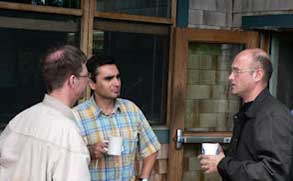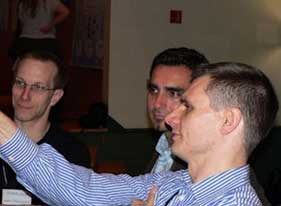Report of the FFPER 2007 International PER Working Group
Genaro Zavala and Brian Pyper
Working Group Members: Enrique Coleoni, Chris Kautz, Mila Kryjevskaia, Yuhfen Lin, Cedric Linder, Brian Pyper, Padraic Springuel, Jing Wang, Genaro Zavala.
 The International PER working group had the task of comparing different PER communities around the world in a way that helps build bridges and further the work of all. The group itself was very international with four out of ten members being from outside the US and four other members originally from outside of but working in the US. Since the task was very broad, we implemented a survey asking people attending the conference about the importance of having connections with other PER groups around the world and the actions the US community should take to make those connections. The following report is a combination of the survey results and our own group discussions on the matter.
The International PER working group had the task of comparing different PER communities around the world in a way that helps build bridges and further the work of all. The group itself was very international with four out of ten members being from outside the US and four other members originally from outside of but working in the US. Since the task was very broad, we implemented a survey asking people attending the conference about the importance of having connections with other PER groups around the world and the actions the US community should take to make those connections. The following report is a combination of the survey results and our own group discussions on the matter.
PER outside the US
There are some differences among the PER communities around the world resulting in part from educational-structure differences. For example, in some Latin-American countries, universities are composed of self-contained schools: an engineering school, for instance, will have engineering professors teaching physics to its students. This arrangement limits the opportunity for physics education research in many universities. In Germany, most physics education research is done with students at pre-university levels, since the structure of the educational system limits access to university students.
Importance of International PER connections
We collected 32 survey respondents of the 48 that were handed out. Respondents reported 25 international connections of various kinds ranging from close collaborations to email consultations and sharing of pre-prints. These connections were found in 15 countries.
Despite PER being different and country-dependent, international links among established PER groups around the globe are beneficial. Good reasons for the US PER community to foster international collaboration include:
- Gaining ideas for productive new research areas or projects in terms of new research approaches or perspectives/ideas;
- Obtaining access to probe culture, different populations, social interactions and language in physics education research;
- Avoiding unnecessary replication in research;
- Improving legitimacy of research through awareness among colleagues of international applications of the goals of PER;
- Attracting potential students and researchers;
- Supporting each other’s research through visits – colloquia or forum talks, sabbatical or Fulbright visits, etc.;
- Gaining awareness of the structure and challenges of foreign school systems;
- Broadening the scope of productive thinking about PER issues through better understanding of foreign perspectives;
- Improving communication among researchers to foster international understanding among nations;
- Fostering opportunities for international collaborations – especially in applications where access to particular research questions is restricted by cultural or language barriers; and
- Increasing the appreciation of other cultures, variety and diversity.
Recommendations to the US PER community
 There is a consensus among the conference participants that that international links will benefit our community. Of the several ideas collected from the surveys, some stood out as more popular among the conference attendees. We filtered these ideas into ten recommendations, which we grouped into three categories: A: We should enact these recommendations immediately, B: We should consider these recommendations for the near future, and C: We should keep these recommendations in mind as we work.
There is a consensus among the conference participants that that international links will benefit our community. Of the several ideas collected from the surveys, some stood out as more popular among the conference attendees. We filtered these ideas into ten recommendations, which we grouped into three categories: A: We should enact these recommendations immediately, B: We should consider these recommendations for the near future, and C: We should keep these recommendations in mind as we work.
A: Enact Immediately
- Invite more international speakers to AAPT/PERC/FFPER and local meetings and colloquia. Specifically, AAPT RIPE and International Physics Education Committees should co-sponsor an “International PER” session at national meetings. [Note: During the 2008 AAPT Summer National Meeting in Edmonton, the Committee on International Physics Education and the Committee on Research in Physics Education are co-sponsoring a session called “PER around the world.” This is a good step the community has taken to start fostering international collaboration and recognition.]
- Compile a list of people willing to help the AAPT Committee on International Physics Education or APS International Relations Office with language and cultural issues in publication, and advocate for foreign research to be included in US journals.
- Add international PER group information to a central web site (such as PERCentral).
- Refine ideas for possible meeting formats for fostering international connections such as joint meetings, cross-pollinating existing meetings (such as GIREP, ICPE, ESERA, CIAEF), etc. This meets the suggestions we received for international meetings, visiting exotic locations, and sampling ethnic cuisine.
B: Consider for the near future
- Might we consider a PER committee on international relations?
- Consider funding for international collaborations in grant proposals.
- Take opportunities to read international journals, consider reviewing up-to-date foreign research for the US PER community (on PhysLrnR or another appropriate venue), and consider submitting your research to international journals for publication.
C: Keep in mind
- Share your international connections.
- Consider taking your next sabbatical in an international setting.
- Watch for opportunities to be involved in international collaborations.
About the Authors:
Genaro Zavala is an Associate Professor of Physics at the Tecnologico de Monterrey, Monterrey, Mexico. Email: genaro.zavala@itesm.mx.
Brian Pyper is a Professor of Physics at Brigham Young University – Idaho, Rexburg, Idaho. Email: pyperb@byui.edu.
